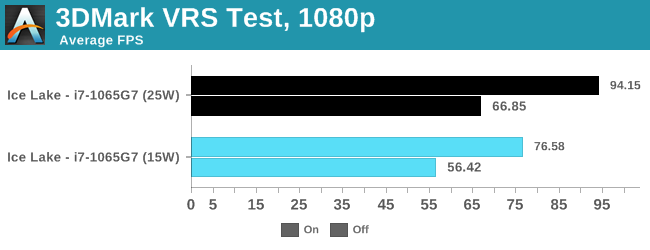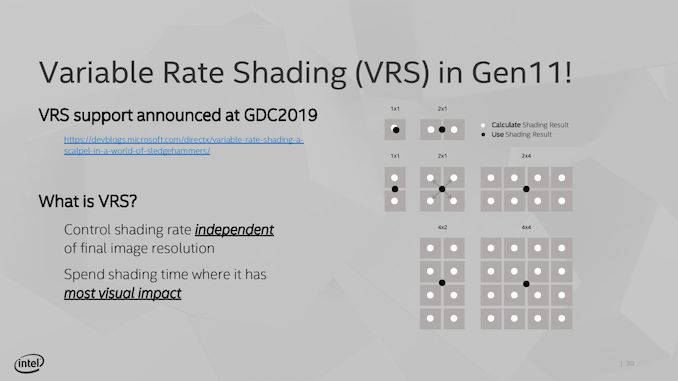The Ice Lake Benchmark Preview: Inside Intel's 10nm
by Dr. Ian Cutress on August 1, 2019 9:00 AM EST- Posted in
- CPUs
- Intel
- GPUs
- 10nm
- Core
- Ice Lake
- Cannon Lake
- Sunny Cove
- 10th Gen Core
Gaming Results (15W and 25W)
One of the biggest changes to the Ice Lake design is in the integrated graphics – Intel is now giving more focus and more die area to graphics, something it has arguably been neglecting for several years now. With Ice Lake, we move to a Gen11 graphics architecture, which is almost like the previous Gen9.5 but now with added support for variable rate shading (VRS), moving from 24 EUs to 64 EUs, and memory support up from LPDDR3-2133 to LPDDR4X-3733.


World of Tanks is a very CPU driven benchmark, and having the extra frequency of the 25W processor does help here. We're getting a sizeable uplift from Whiskey Lake, due to the extra EUs and memory frequency.


Our Final Fantasy test seemed to regress in 25W mode, although still within the noise. This test is still GPU bound, so adding the extra TDP to the CPU didn't actually help much. However, comparing to the Whiskey Lake integrated graphics, we've got over a 2x speedup.


Similarly with Civilization, with what is normally our 'IGP' settings, we are still GPU limited here.
One of Intel's newest features is Variable Rate Shading.
If developers add the option, soon to be an easy checkbox in Unity and Unreal, the game can decide to control the rate at which it shades pixels, from calculating every pixel down using one result across a 4x4 grid, to save compute power. Currently the only way to test this is with the 3DMark functional demo.

The new VRS test in 3DMark is designed as a feature test to show the potential uplift effect from enabling variable rate shading within a game. In both 15W and 25W modes, the data saw a good uplift, and we seemed to get more out of the 25W mode than the 15W mode.














261 Comments
View All Comments
rangerdavid - Friday, August 2, 2019 - link
What Moizy said. Ian, you are quite fair and diplomatic in your responses. And if you are in some kind of Intel marketing conspiracy, for heaven's sake, I hope you are getting a good cut! Buy yourself something pretty, fella... (grin)0ldman79 - Friday, August 2, 2019 - link
Rock on man.Well said.
Sailor23M - Monday, August 5, 2019 - link
+1 Moizy thanks. I really do not have the time to go searching and collecting all the leaks out there, so this article was well timed for me and at a high level lets me know what to expect from these chips.close - Monday, August 5, 2019 - link
@Moizy: I guess props to AT if this turns out to be the real situation.Curious what happens if we have another "oh our puff piece didn't notice they were using a sub 0 chiller under the table" kind of situation. Last time there was an anemic "oh, yeah, Intel could have been more straight forward" type reaction. So you can understand why people are skeptical about results that can't be independently validated, even (especially? ...given past experiences) if they come from AT.
tijag - Thursday, August 1, 2019 - link
You sir are a first rate obtuse troll.chowmanga - Thursday, August 1, 2019 - link
Would you say there was a difference between getting a product in advance and getting one when the rest of the press gets one?Moizy - Thursday, August 1, 2019 - link
To me, the only meaningful difference is timing. The unsound logic of the argument is a) Intel invites a few select press to a preview event months before availability, b) the select few press are flattered by the privilege and develop positively biased feelings toward Intel, therefore c) they report positively biased, flawed findings due to the privilege.It's true that inviting a select few to the event could psychologically influence those few, making them slightly less objective than they may have otherwise been. But Ian's reporting isn't built on subjective opinions on Icy Lake, 10nm, and Intel. His reporting is built on his objective testing, using his standardized benchmarks. So even if Ian's view of Intel and Icy Lake were a little swayed by this privilege (which I doubt they were, he's not a new kid on the block, he deals with PR and Marketing and the like all the time), for this to translate into flawed, biased reporting, Ian would need to purposefully alter his standardized benchmarks in order to produced positively biased results. There is zero evidence that he did that here, and there is zero precedence to him doing that in the past, so the original logic is extremely flawed.
uberDoward - Friday, August 2, 2019 - link
Based on the fact (as Ian mentioned at the beginning of the article) it DOES sound like others that were invited came unprepared, and willing to just spout Intel's rhetoric without objective measurements. Kudos to Ian for arriving prepared!Santoval - Friday, August 2, 2019 - link
You are ranting but saying nothing substantial or even anything that makes sense. "Conflict of interest"? Really? In what way exactly, do you think they gifted Ian and the other AnandTech editors a few hundreds of Intel shares each? Maybe they gave them free vacations to Bali just to "thank" them? Or free top-end Intel based laptops and Intel SSDs for the next 5 years?These examples *would* be conflicts of interest. Previewing an Ice Lake reference design while pointing out an entire list of caveats and limitations is not an example of a conflict of interest. "Professional distance" does not mean declining a product preview (why on Earth should they?), it means keeping an equal distance from all the companies the products of which you preview.
bcronce - Friday, August 2, 2019 - link
I learned a lot. Like trade-offs between latency and throughput in several different ways. Or increase in cache-hits vs latency.